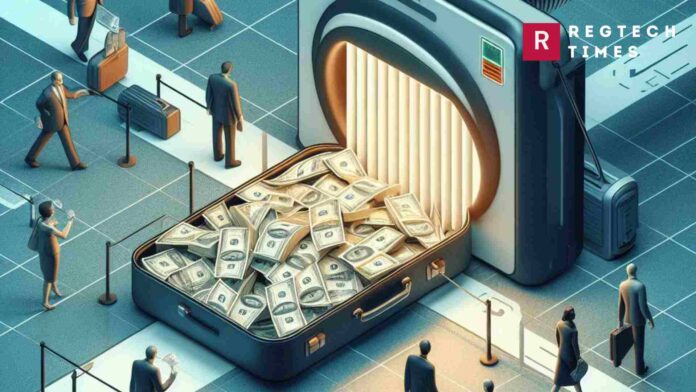Money laundering through airports involves a complex modus operandi that takes advantage of vulnerabilities in airport security and international travel regulations. Criminals use various techniques to smuggle large sums of cash across borders without detection.
Laundering through airports, or airport cash smuggling, is a method used by criminals to move large sums of cash across international borders without detection. This process involves individuals, known as couriers, carrying illicit funds in their luggage or on their person as they travel by air from one country to another.
The cash is then bundled and concealed in luggage or clothing to avoid detection by airport security. Couriers often travel on commercial flights, using their personal or fake identities to avoid suspicion.
Once the couriers arrive at their destination, they either deposit the cash into bank accounts or exchange it for other assets, such as gold or cryptocurrency. By laundering the cash through airports, criminals can avoid traditional banking systems and the scrutiny of financial regulators, making it easier to conceal the illicit origin of the funds.
Airport cash smuggling poses a significant challenge to law enforcement agencies, as it is difficult to detect and prevent.
Example of Laundering through Airport
The orchestrator leverages their connections and knowledge of airport procedures to exploit vulnerabilities in the system. They carefully plan each step of the operation to minimize the risk of detection, including using multiple couriers to carry smaller amounts of cash, ensuring that no single courier exceeds the threshold for declaring the funds to customs.
In addition to coordinating the logistics, the orchestrator is also responsible for laundering the funds once they reach their destination. This could involve exchanging the cash for other assets, such as gold or cryptocurrency, or funnelling it through legitimate businesses to obscure its illicit origin.
Orchestrator plays a critical role in the money laundering scheme, using their expertise and connections to facilitate the movement of illicit funds across borders. Their actions highlight the sophistication and complexity of modern money laundering operations, which continue to pose a significant challenge to law enforcement agencies worldwide.
Smurfing as the tool for Laundering Through Airports
One common method is to use multiple individuals to carry smaller amounts of cash, known as “smurfing.” Each individual carries an amount below the threshold that would require them to declare it to customs authorities. Once the cash reaches its destination, it is consolidated and laundered through various means, such as purchasing assets or funnelling it through shell companies.
Read More About Money Laundering
Another method involves using legitimate businesses as a front to disguise the illicit origin of the funds. Criminal organizations may set up shell companies or use existing businesses to create a paper trail that makes the money appear to be from legitimate sources. This can involve false invoicing, fake contracts, or other fraudulent documents to justify the movement of funds.
Cryptocurrencies are also increasingly being used for money laundering. Criminals can convert cash into cryptocurrencies and transfer them across borders with relative anonymity. Once the funds reach their destination, they can be converted back into cash or used to purchase goods and services.
To evade detection, money launderers often exploit gaps in airport security and customs procedures. They may use private jets or charter flights to avoid standard screening processes. They may also use diplomatic channels or other means to bypass customs inspections.
To combat money laundering through airports, authorities have implemented various measures, such as enhanced screening procedures, increased cooperation between law enforcement agencies, and stricter regulations on cash transactions. However, money launderers continue to adapt their tactics, highlighting the ongoing challenge of combating financial crime in the global aviation industry.


